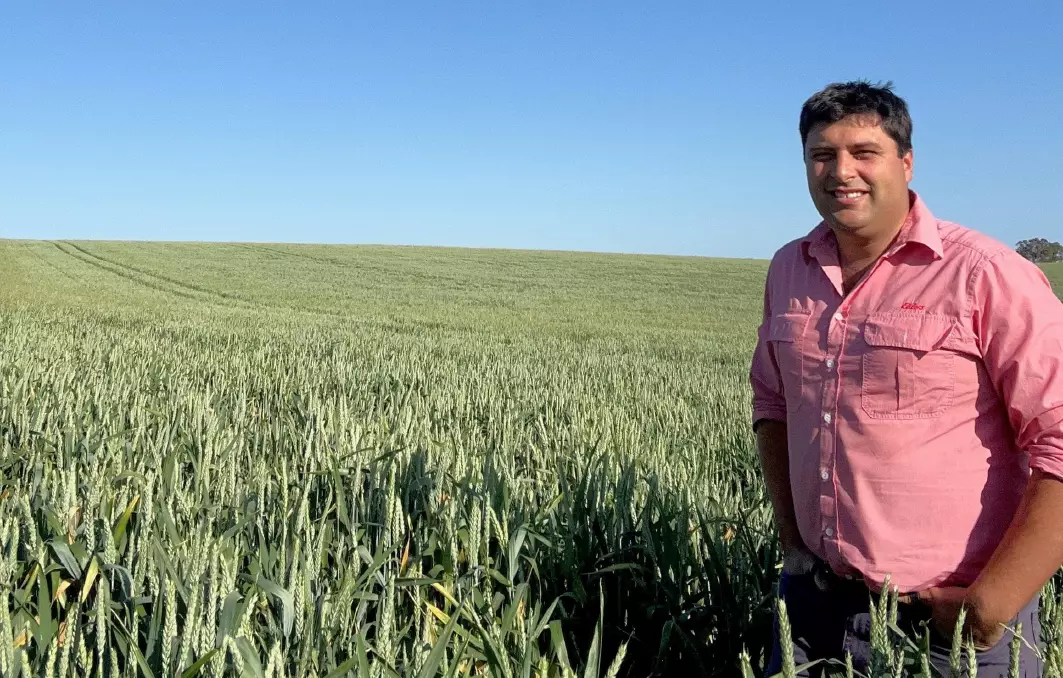Canowindra crops escape major frost damage

Canowindra mixed farmer and Elders area agronomist Ben Romeo in a paddock of Sunlamb wheat at Bellevue. Photos: Supplied
Canowindra mixed farmer Ben Romeo is counting his lucky stars that this year's crops appear to have escaped major damage from three days of frost last month.
"We are in a very fortunate position compared to surrounding areas," he said.
"We were all dreading walking into these paddocks ... There was a lot of angst for a couple of weeks after the big frost events, but - touch wood - we've been okay, with minor damage. I feel for the farmers to the south, because they've just been devastated with it."
Mr Romeo, who is also area agronomist for Elders, said talking to clients and comparing their crops with his own suggested several factors that potentially saved them from the worst. These included receiving rain the week before and temperatures not remaining below zero for an extended period.
Mr Romeo farms 400 hectares of mostly undulating red brown soils with parents, Bernard and Joanne, at Bellevue, near Canowindra in the Central West of NSW.
They produce dryland winter cereal, legume and oilseed crops, as well as forage crops and turn off up to 400 Angus trade steers each year.
This year's crops include Sunlamb wheat, Luxor lupins, Hyola 970 canola and Monola H524TT, and phalaris-clover based pastures.
The usual rotation is a legume, followed by canola, then wheat.
Mr Romeo said their enterprise was predominantly dual-purpose cropping designed to extract the highest gross margins possible from a relatively small acreage in a tightly held area.
"Dad and myself are always trying to look at the next thing and how we can push our country," he said.
"As much as we would love to expand, and we are always trying to, we've just got to get as much out of our country as we possibly can."

Monola H524TT in flower. Despite a challenging season, the Romeos' first crop looks like yielding 2.5 tonnes per hectare or more.
Monola had always been "off the radar" because of the yield penalty in comparison to standard TT canola varieties, but Mr Romeo changed his tune after chatting with a Nuseed rep earlier in the year.
Attracted by the lure of a $100 a tonne premium and data showing yields less than 5 per cent under leading canola varieties, the Romeos planted a test crop of 43ha of Nuseed H524TT.
"I was always going to put a spring crop of TT canola in this year, just to clean a couple of paddocks," he said.
"So far, I've been very, very pleased with the monola. It looks like yielding north of 2.5t/ha, which is ticking all the boxes for me, and I've got clients looking over the fence who want to see how it goes."
Preparation began with burning two paddocks of wheat stubble, followed by application of the pre-emergent herbicide simazine with a knockdown.
Using an Agrodrill, the crop was sown at 3kg/ha of seed on 150mm row spacings, with mono ammonium phosphate at 80kg/ha.
At the six-leaf stage, it was sprayed with Select Xtra, Lontrel Advanced and Atrazine herbicides, and the fungicide Aviator Xpro at 20pc flowering. Urea at 200kg/ha and Gran-am at 80kg/ha were spread in-crop.
"Then we just watched it," Mr Romeo said.

Angus steers graze a paddock of Sunlamb wheat. The Romeos focus on dual-purpose cropping to maximise gross margins at their farm, Bellevue, near Canowindra.
A contractor will direct harvest the crop in mid to late November and it will be sent to MSM Milling, Manildra, which produces an oil is a healthy alternative to cooking oils that have high levels of saturated and trans-fat for the fast-food chains such as KFC and McDonald's.
After a wet start to the season which delayed sowing and caused waterlogging in low lying areas, Mr Romeo said some of their other crops struggled.
The Hyola 970 canola was sown in March and heavily grazed in May-June, while the wheat was sown late in April and grazed lightly in June-July.
Wet paddocks prevented them from timely application of in-crop herbicide against broadleaf and grass weeds such as wireweed, prickly lettuce, wild oats.
Disease pressure has been high, with sclerotinia and aerial blackleg appearing in canola, and stripe rust in wheat.
The Romeos turned to aerial application of fungicide on the canola and insecticide on lupins to guard against heliothis and aphids.
Average annual rainfall at Bellevue is about 600mm, but Mr Romeo said they had already recorded 659mm so far this year.
A drier spell in September forced crops to dig deeper for moisture, but recent rain and storms that delivered from 6mm to 30mm have freshened them up.
Mr Romeo said the wheat looked like yielding 4.5-5t/ha and the canola 2.5t/ha.
